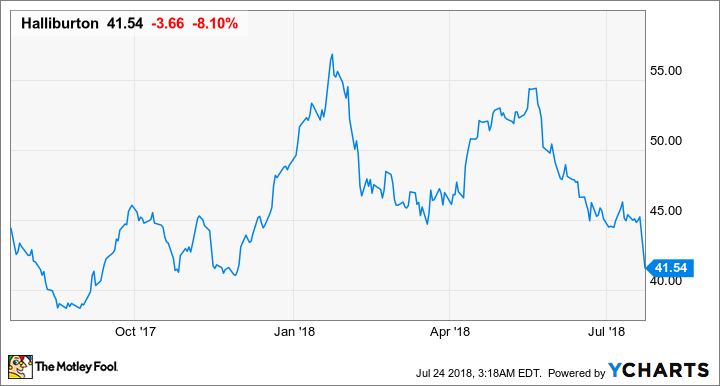Based on Wall Street's reaction to Halliburton's (HAL -0.22%) most recent earnings report, one would think that the report was littered with red flags. That wasn't the case, though, as its earnings result was right in line with expectations. However, management did let investors know that the rest of 2018 will be a little tougher, which led to the 8% drop.
Was the announcement that earnings for the next quarter will be flat enough of a reason to send shares tanking the way they did? Let's dig into the company's most recent report to see if there were some other signs of concern.

Image source: Getty Images.
By the numbers
| Metric | Q2 2018 | Q1 2018 | Q2 2017 |
|---|---|---|---|
| Revenue | $6.14 billion | $5.74 billion | $4.96 billion |
| Operating income | $789 million | $354 million | $146 million |
| Diluted EPS | $0.58 | $0.05 | $0.03 |
| Free cash flow | ($107 million) | $198 million | $38 million |
DATA SOURCE: HALLIBURTON EARNINGS RELEASE. EPS = EARNINGS PER SHARE.
The past couple of quarters were adversely impacted by writedowns related to its business in Venezuela with the national oil company PDVSA. This quarter, though, we saw the income statement unburdened by writedowns and impairments. It was yet another rather impressive result as revenue grew 24% year over year and operating margins expanded to 12.8%.
As has been the case, North American shale drilling was the driving force for the company's most recent result. Even though revenue was up a decent clip in that region -- 9% compared to the prior quarter -- it was able to extract higher prices from customers because utilization rates of equipment and crews are high in shale basins such as the Permian.
Outside North America, Halliburton continued to have mixed results as increased activity in places like the Middle East and Mexico more than offset weakness in the North Sea and Angola. This part of the business is likely going to take a much slower pace than in North America, but the trend points to more spending from which Halliburton and others should benefit.

Data source: Halliburton earnings release. Chart by author.
One thing that looks a little discouraging in these results is the lack of free cash flow this past quarter. Digging a little deeper, this isn't nearly as bad as it looks. On top of the $565 million in capital spending this past quarter, it also spent $307 million in marketable securities (think buying short-term bonds instead of holding cash) and $148 million on acquisitions including an upstream chemicals manufacturer. Considering that the company generated over $1 billion in operating cash flow in the quarter, it seems as though now is as good of a time as any to make these kinds of moves.
What management had to say
For the past couple of years, CEO Jeff Miller has been one of the most ardent cheerleaders of North American shale and its growth potential. That growth, however, is starting to create some issues of abundance that Miller thinks could lead to a softening market in the second half of the year.
In some ways, we're a victim of our own success as we develop longer laterals with better production. As a result, we expect this area to have temporary softness in the back half of 2018. But it's poised to regain activity as the calendar turns to 2019, and additional pipeline capacity is available. We will manage through the year-end and be ready for the increased activity next year. I expect that these temporary efficiency drags will create headwinds for additional upward pricing in the third quarter. Our competitors' new and uncontracted equipment is also creating pricing pressure in some areas. We will continue our efforts to optimize pricing and utilization, pursue continued technology implementation, and control cost to maintain our industry-leading returns.
You can read a full transcript of Halliburton's conference call here.
A market overreaction?
Halliburton has experienced incredible growth in the North American shale patch over the past couple of years. Even though management says that it will likely hit a slow patch in the second half of this year, the reasons for the slow patch are because the Permian Basin has grown so fast and the infrastructure supporting it is bursting at the seams (figuratively speaking, of course).
It should be noted, though, that a slowdown in the Permian Basin doesn't mean the business will stop growing. There are other shale basins that are growing (the STACK formation in Oklahoma, the Bakken in North Dakota, and the Niobrara in Colorado) and the international market is likely going to continue its measured progress upward.
Ultimately, it would appear that Wall Street is putting a lot of emphasis on the next six months because Halliburton the business appears to be well positioned in the longer term. It's entirely possible that shares could decline even more over this soft patch, though, so maybe it's worth seeing what happens over the next quarter or so before taking any action with this stock.






